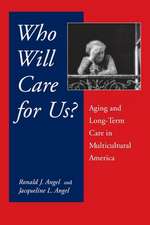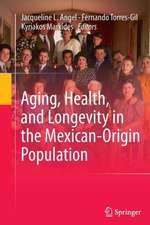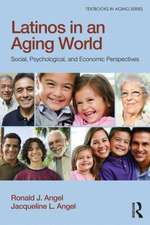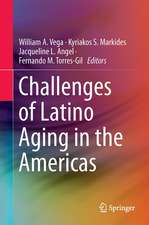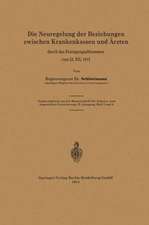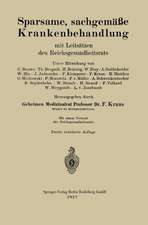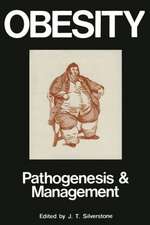The Health of Aging Hispanics: The Mexican-Origin Population
Editat de Jacqueline L. Angel, Keith E. Whitfielden Limba Engleză Hardback – 20 feb 2007
| Toate formatele și edițiile | Preț | Express |
|---|---|---|
| Paperback (1) | 361.88 lei 39-44 zile | |
| Springer – 25 noi 2010 | 361.88 lei 39-44 zile | |
| Hardback (1) | 396.40 lei 6-8 săpt. | |
| Springer – 20 feb 2007 | 396.40 lei 6-8 săpt. |
Preț: 396.40 lei
Nou
Puncte Express: 595
Preț estimativ în valută:
75.85€ • 79.04$ • 62.80£
75.85€ • 79.04$ • 62.80£
Carte tipărită la comandă
Livrare economică 03-17 aprilie
Preluare comenzi: 021 569.72.76
Specificații
ISBN-13: 9780387472065
ISBN-10: 0387472061
Pagini: 290
Ilustrații: XIV, 290 p.
Dimensiuni: 155 x 235 x 19 mm
Greutate: 0.61 kg
Ediția:2007
Editura: Springer
Colecția Springer
Locul publicării:New York, NY, United States
ISBN-10: 0387472061
Pagini: 290
Ilustrații: XIV, 290 p.
Dimensiuni: 155 x 235 x 19 mm
Greutate: 0.61 kg
Ediția:2007
Editura: Springer
Colecția Springer
Locul publicării:New York, NY, United States
Public țintă
Professional/practitionerCuprins
Setting the Stage: Hispanic Health and Aging in the Americas.- Setting the Stage: Hispanic Health and Aging in the Americas.- Exploring the Health Consequences of Hispanic Mortality.- Health Status of Elderly Hispanics in the United States.- Census Disability Rates Among Older People by Race/Ethnicity and Type of Hispanic Origin.- Disability and Active Life Expectancy of Older U.S.-and Foreign-Born Mexican Americans.- Predictors of Decline in Cognitive Status, Incidence of Dementia/CIND and All-Cause Mortality in Older Latinos: The Role of Nativity and Cultural Orientation in the Sacramento Area Latino Study on Aging.- Education and Mortality Risk Among Hispanic Adults in the United States.- Does Longer Life Mean Better Health? Not for Native-Born Mexican Americans in the Health and Retirement Survey.- Contextualizing Support and Mexican-Origin Health in Old Age: Issues of Family, Migration, and Income.- Dynamics of Intergenerational Assistance in Middle- and Old-Age in Mexico.- Aging, Health and Migration: The Voices of the Elderly Poor in Mexico.- Aging and Health Interrelations at the United States-Mexico Border.- Colonias, Informal Homestead Subdivisions, and Self-Help Care for the Elderly Among Mexican Populations in the United States.- Access to Health Care Services Among Elderly Hispanics with Special Reference to Mexican Americans.- Disparities and Access Barriers to Health Care Among Mexican American Elders.- Lack of Health Insurance Coverage and Mortality Among Latino Elderly in the United States.- Access Issues in the Care of Mexican-Origin Elders: A Clinical Perspective.- Cross Border Health Insurance and Aging Mexicans and Mexican Americans.- Cultural Myths and Other Fables About Promoting Health in Mexican Americans: Lessons Learned from Starr County Border Health Intervention Research.- Health Insurance Coverage and Health Care Utilization along the U.S.–Mexico Border: Evidence from the Border Epidemiologic Study on Aging.- Options for Health Care Reform.- Impoverishing and Catastrophic Household Health Spending Among Families with Older Adults in Mexico: A Health Reform Priority.- The Health Care Safety Net for Hispanics.- Afterword Globalization and Health: Risks and Opportunities for the Mexico—U.S. Border.
Textul de pe ultima copertă
The Health of Aging Hispanics: The Mexican-Origin Population
edited by
Jacqueline L. Angel
University of Texas at Austin, Austin, Texas
and
Keith W. Whitfield
Pennsylvania State University, University Park, Pennsylvania
The population of the United States, like that of most other nations, will age rapidly well into the 21st century. By 2025, at least one-fifth of the population in 15 countries in the Americas is to be age 60 or over. Additionally, as the result of high immigration and fertility rates, as well as improvements in life expectancy, the United States Census Bureau projects that by 2050, the total number of non-Hispanic white aged 65 and over will more than triple, and the number of Hispanics in this age bracket will increase eleven fold. Despite these demographic facts, there is a significant dearth of information about the unique strengths and characteristics that underrepresented minority possess and experience as they age. Further examination of these understudied groups, especially among Hispanics – now the nation’s largest minority group – offers the possibility to promote healthy aging for the entire nation.
In this unique volume, contributions provide initial information on numerous factors that affect the health security of Mexican-origin families and individuals as they face the burdens of decline in health status and caring for children and the elderly simultaneously, including health issues before and after immigration. Also included is material addressing important issues related to the contemporary political debate on immigration and healthcare reform in the United States and Mexico. In the coming decades, collections such as this will be critical to develop a better understanding of how immigration from Latin America, Asia and Africa to the United States produces health disparities in our aging population.
edited by
Jacqueline L. Angel
University of Texas at Austin, Austin, Texas
and
Keith W. Whitfield
Pennsylvania State University, University Park, Pennsylvania
The population of the United States, like that of most other nations, will age rapidly well into the 21st century. By 2025, at least one-fifth of the population in 15 countries in the Americas is to be age 60 or over. Additionally, as the result of high immigration and fertility rates, as well as improvements in life expectancy, the United States Census Bureau projects that by 2050, the total number of non-Hispanic white aged 65 and over will more than triple, and the number of Hispanics in this age bracket will increase eleven fold. Despite these demographic facts, there is a significant dearth of information about the unique strengths and characteristics that underrepresented minority possess and experience as they age. Further examination of these understudied groups, especially among Hispanics – now the nation’s largest minority group – offers the possibility to promote healthy aging for the entire nation.
In this unique volume, contributions provide initial information on numerous factors that affect the health security of Mexican-origin families and individuals as they face the burdens of decline in health status and caring for children and the elderly simultaneously, including health issues before and after immigration. Also included is material addressing important issues related to the contemporary political debate on immigration and healthcare reform in the United States and Mexico. In the coming decades, collections such as this will be critical to develop a better understanding of how immigration from Latin America, Asia and Africa to the United States produces health disparities in our aging population.
Caracteristici
Addressing the demographic trends affecting Latinos in the United States, Mexico and Latin America – particularly the aging of the Hispanic population and its resultant health and long-term needs Focussing on the growing Hispanic population in the United States, this book indirectly addresses social issues such as culture, poverty, immigration, education, employment, and civil rights An examination of the effect of migration on the health of the elderly – contrasting those who migrated and those who did not





